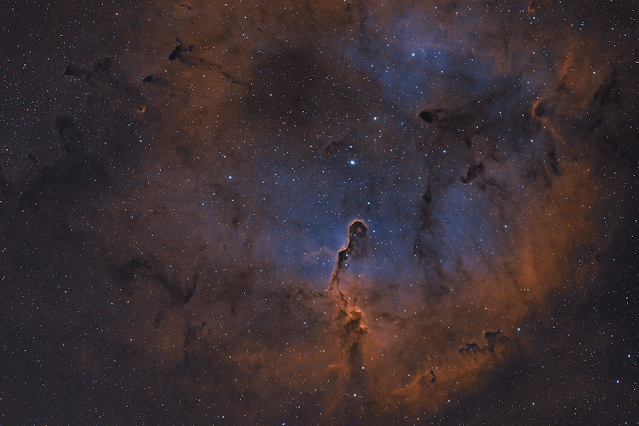It was an unexpected clear night and a Friday night too!
Clear skies on a Friday night and daylight savings time actually working to my advantage. Noticed potential for clear skies that morning of July 7th but didn't get my hopes up too high. Got home from work, went to dinner, ran a few errands, and got home in plenty of time to setup before dark. Since the Moon was going to rise at midnight, figured it would be good to after an emission nebula so I could try out my L-eXtreme Dual Narrowband filter out with my ZWO ASI2600MC Pro for the first time. Got great results with the filter last year with my DSLR. I decided to shoot IC 1396, The Elephant Nebula in the constellation Cepheus.
Started capturing 180 sec subs at 10:18 PM and kept going until 4:06AM, when I went outside to take flat frames. Ended up using 79 subs, resulting in a total exposure of 3.95 hours. The image was processed in PixInsight using a Dual Narrowband "SHO" method that was provided to me by a mentor from the Buffalo Astronomical Association. This method approximates the SHO or Hubble Palette color map scheme with data from dual Narrowband filters and one-shot color (OSC) cameras like mine.
This is the resulting image.
 |
| IC1396 - The Elephant Trunk Nebula from 07/07/2023 |
What is it?
IC 1396 is a region of ionized interstellar gas and dust that contains smaller regions of concentrated gas and dust that appear as dark knots or globules in visible light images. The gas in the entire region is being ionized by the bright star HD 206267 in the center of the image. The Elephant Trunk Nebula is one of those concentrations of gas and dust. It can be seen rising from the bottom of the image. These areas of concentrated gas and dust, including The Elephant Trunk, are star forming regions. Young stars within The Elephant Trunk were discovered in 2003 using infrared telescopes.
How big is it?
The entire region is hundreds of light years across and spans over 3 degrees on the night sky.
How far is it?
IC 1396 is located about 2,400 light-years (ly) in the Constellation Cepheus.
How to find it?
The constellation Cepheus is located near the bright signpost constellation Cassiopeia. Cepheus is a circumpolar constellation for observers at mid-northern latitudes and above. This means the constellation never sets. It is visible all night, appearing to circle the north celestial pole currently located near the North star, Polaris. to me, this constellation looks like a house with disproportionately large roof. IC 1396 is indicated in the chart by the red rectangle just off what would be the ground floor of the house.
 |
| Finding Chart for IC 1396 (the red rectangle in the center of the chart). |







